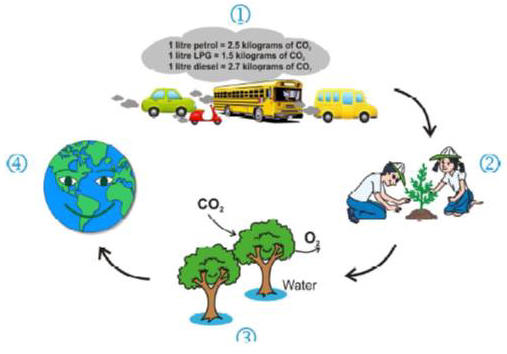Cut The Carbon
A
s the Indian economy continues to grow defying global recession, there is another parallel and connected growth curve that is spelling bad news not only for the health of the planet but also for the sustainability of the economic growth itself. We are referring here to the growth of an average Indian’s carbon footprint. While it is still, in per capita terns, much below the global figure, within the country there is considerable data variability between rural and urban spaces.As India has been continuing to urbanise at a rapid pace with the number of towns increasing from about 5000 in 2001 to nearly 8000 in 2011, carbon intensive lifestyle patterns are getting increasingly adopted across the country and specially in the urban centres. Large corporations that have been garnering huge profits by promoting carbon intensive products and services continue to glorify and advertise consumerist and unsustainable lifestyles, particularly among the youth and children who are at an impressionable age. The extensive reach of the media into the remotest corners of the country has aided and abetted this process.
It is imperative to generate
awareness, particularly amongst the young population of the causes and
implications of our increasing carbon footprint so that a sense of ownership
of and responsibility for the state of the environment is promoted.
Innovative approaches and tools have to be adopted to reach out to today’s
youth.
The nation-wide Community Led Environment Action Network (CLEAN-India) programme of Development Alternatives (DA) that works with school children, youth and urban as well as rural communities to make them environmentally aware and active has risen to this challenge. The underlying principle of the CLEAN-India programme is that each one of us is responsible for the current state of environment in the country and we cannot wait for someone else to solve the problem. With this basic premise, the CLEAN-India programme trains youth brigades to become environmental activists by turning them into agents of change for building sustainable societies and creating a global impact while acting at the local level.
CLEAN-India has launched the Cut the Carbon programme targeting the urban youth. The programme has been designed with schools as the nodal point for generating an awareness of new ideas among the children and a realisation that they can be excellent agents for change, capable of influencing their families, friends and neighbors.
Under this programme, students are trained to calculate carbon footprints of their school using simple tools of data collection and analysis. They take into account energy consumption, transportation, recycling practices etc. One of the tools employed in this programme is a carbon calculator developed by the CLEAN-India team. It is a CD based application that does not merely measure one’s GHG emissions, but goes a step further suggesting some simple ways to reduce the carbon footprint.
Once the carbon footprint of the school has been calculated, an awareness campaign is conducted to promote suitable actions aiming at reduction of the emissions at an individual and institutional level. Students also conduct a tree plantation drive where they are encouraged to adopt individual saplings on the campus and take care of them. Subsequently a second assessment is done to calculate the total reduction in emissions achieved by the collaborative efforts of the students and the school management. Finally the school is awarded a plaque stating the degree of their carbon footprint reduction and congratulating the students on their achievement. Students are also encouraged to replicate the process at home and in their neighborhoods to achieve a still larger positive impact.
Similar awareness programmes based on innovative approaches need to be taken up across the length and breadth of the country to help children become change agents in their communities. q
Mayukh Hajra
mhajra@devalt.org